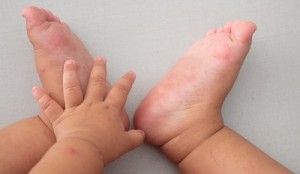The Not-So-Obvious Facts of Hand, Foot, and Mouth Disease
By S. Chad Hayes, MD, FAAP
Hand, foot, and mouth disease (HFMD) is a common illness in young children and a frequent reason for a visit to the pediatrician. Like the other cause of preschool panic (conjunctivitis, or “pink eye”), HFMD is typically a mild illness that causes a lot more worry than it should.
This illness can affect people at any age, but it is seen most frequently in preschool-age children, most often in the late summer or early fall. It can be caused by several different viruses—usually strains of Enterovirus or Coxsackievirus. So while most children will develop long-lasting immunity after an infection, they can still get HFMD again if they are infected by one of the other strains.
This viral infection can cause painful blisters in the mouth and a rash that often shows up on the arms, legs, and buttocks, in addition to the places you already guessed based on the name. The rash can look like red spots, blisters, or bumps, and it’s usually not itchy or painful. Many kids will have a fever as well.
For the vast majority of children, HFMD will go away by itself in about a week without causing any major issues. The most common complication is dehydration, which can happen if a child refuses to drink due to the painful mouth blisters. Dehydration can usually be prevented by treating pain with ibuprofen or acetaminophen and encouraging fluid intake (popsicles count!). Rarely, children who are unable to stay hydrated will need to be admitted to the hospital for IV fluids until the illness gets better. Other than that, there’s usually nothing else to do, because we don’t have any magic to make HFMD go away faster.
One little-known complication of HFMD is the loss of fingernails and toenails within a few weeks of the infection. Fortunately, this condition called onychomadesis is relatively rare. Even more fortunately, nails tend to grow back normally.
The viruses that cause HFMD can be spread by saliva, but more often, they infect new people via the “fecal-oral route.” This is a method of disease transmission that involves swallowing poop particles—an event that occurs far more commonly than most of us care to imagine. If you have trouble understanding how this could possibly happen, try volunteering at a daycare for a couple hours. Or keeping a handwashing log in the bathroom at your favorite taco shop. Or just trust me.
The best way to prevent the spread of HFMD is by good handwashing and hygiene practices, especially in places like daycares or preschools that deal with a lot of dirty diapers. This is far more important and effective than excluding kids with HFMD from daycare or school, because these viruses can be shed in the stool for several weeks after the rash resolves. Additionally, some people can be infected with these viruses without developing any symptoms, while stealthily spreading it to anyone who comes into contact with them…or, well, their poop.
Many parents are surprised to learn that HFMD shouldn’t keep kids out of school or childcare facilities. If a teacher or administrator tells you differently, try referring them to the guidance published by the North Carolina Department of Health and Human Services, which specifically says that exclusion is not required.
While HFMD is usually a mild disease that resolves without treatment, there are a few rare complications, as well as several other illnesses that can have similar symptoms. So as always, if you have concerns about your child’s health, contact your pediatrician’s office. Sorting those things out is what we do best.
Dr. Hayes is a pediatrician at South Lake Pediatrics, Huntersville, an Atrium Health Levine Children’s practice. His writing can be found on his blog at chadhayesmd.com and in several other publications, including the Washington Post and Newsweek.
This blog was produced in partnership with Charlotte Parent. Click here for the original post and other parenting resources.














